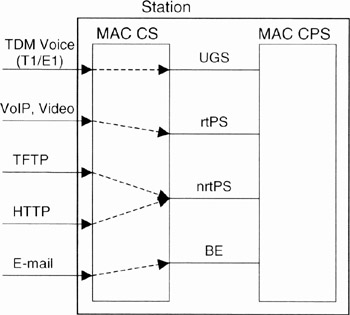8.8 Scheduling and Link Adaptation
8.8 Scheduling and Link Adaptation
Scheduling will be described in Chapter 11. At this stage, some scheduling principles will be introduced that will be used before Chapter 11. Scheduling services are globally the data handling mechanisms allowing a fair distribution of resources between different WiMAX/802.16 users. Each connection is associated with a single data service and each data service is associated with a set of QoS parameters that quantify aspects of its behaviour, known as a QoS class.
Four classes of QoS were defined in the 802.16-2004 standard (and then in WiMAX):
-
Unsolicited Grant Service (UGS);
-
real-time Polling Service (rtPS);
-
non-real-time Polling Service (nrtPS);
-
Best Effort (BE).
A fifth one has been added with 802.16e: extended real-time Polling Service (ertPS) class.
The purpose of scheduling is to allow every user, if possible, to have the suitable QoS required for his or her application. For example, a user sending an email does not require a real-time data stream, unlike another user having a Voice over IP (VoIP) application.
The main mechanism for providing QoS is to associate packets crossing the MAC interface into a service flow as identified by the CID. As already mentioned in the previous chapter, the MAC CS layer makes the classification of different user applications in these five classes of services. Once that operation is made, the role of the MAC CPS layer is to provide the connection establishment and maintenance between the two sides. Figure 8.11 shows an illustration of scheduling mechanisms in a station (BS or SS).

Figure 8.11: Scheduling mechanisms in a station (BS or SS). (From IEEE Std 802.16-2004 [1]. Copyright IEEE 2004, IEEE. All rights reserved.)
In the PMP mode, the BS controls both uplink and downlink scheduling. Uplink request/grant (see Chapter 9) scheduling is performed by the BS with the intent of providing each subordinate SS with a bandwidth for uplink transmissions or opportunities to request the bandwidth.
The link adaptation allows a fair performance for the different applications and a good optimisation of using the radio resources, realising the QoS required for the transmission of the data streams. The link adaptation is an adaptive modification of the burst profile, mainly modulation and channel coding types, that take place in the physical link to adapt the traffic to a new radio channel condition. If the CINR decreases, change is made to a robust modulation and coding to improve the performance (data throughput); otherwise a less robust profile is picked up. For more details on the link adaptation and burst profile transitions see Chapter 11.
EAN: 2147483647
Pages: 124